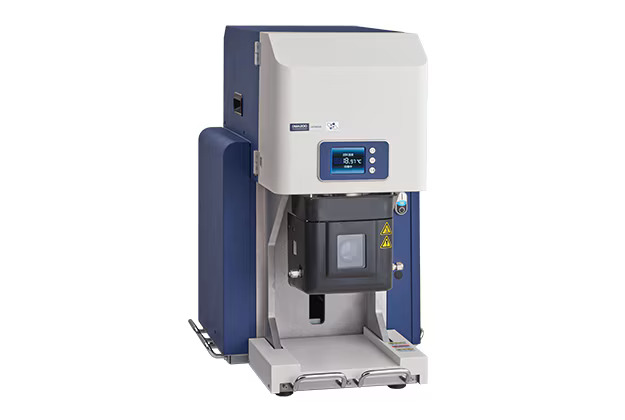Blog Standard
.jpeg)
Unraveling the Dynamic Viscoelastic Properties of Polytetrafluoroethylene(PTFE)
Polytetrafluoroethylene (PTFE), widely known as Teflon, is a high-performance polymer celebrated for its exceptional chemical resistance, low friction, and thermal stability. But what truly sets PTFE apart is its complex viscoelastic properties, which dictate how the material behaves under different stress, temperature, and frequency conditions. Understanding this behavior is crucial for optimizing PTFE’s performance across industries, from aerospace to medical devices. Let’s dive deep into the science behind PTFE’s dynamic viscoelasticity and what it means for real-world applications.
Dynamic Viscoelasticity: The Science Behind PTFE’s Flexibility and Strength
PTFE’s viscoelastic nature means it exhibits both elastic and viscous behavior, making it capable of storing and dissipating mechanical energy. Dynamic Mechanical Analysis (DMA), facilitated by Hitachi’s NEXTA® DMA200, is the key technique used to explore these properties, measuring critical parameters like the storage modulus, loss modulus, and complex modulus:
Storage modulus (E’):
Represents the elastic portion of the material, indicating its stiffness.-
Loss modulus (E”):
Measures the viscous response, representing energy lost as heat. -
Complex modulus (E):
* Combines E’ and E” to give a complete view of the material’s mechanical response.
The loss factor (tanδ), which is the ratio of E” to E’, reveals crucial information about damping characteristics, highlighting how PTFE can absorb and dissipate energy — a key feature for applications involving vibrations or dynamic loads.

Hitachi’s NEXTA® DMA200
Transition Temperatures and Molecular Mobility
Understanding PTFE’s behavior requires studying how its mechanical properties change with temperature. The study identified three key transitions that reveal the polymer’s molecular dynamics:
-
α Transition (Glass Transition):
Occurs at 123°C (at 1 Hz) with an activation energy (ΔEa) of 347 kJ/mol. This marks a shift from a rigid to a more flexible state, where polymer chains gain mobility. -
β Transition (Crystal Polymorphism):
Detected at 21°C, with ΔEa of 286 kJ/mol. This transition is linked to crystal polymorphism, where PTFE exhibits multiple crystalline structures, directly impacting its mechanical and thermal properties. -
γ Transition (Local Mode Relaxation):
Appears at -99°C, with ΔEa of 93 kJ/mol, reflecting localized chain motions within the polymer matrix.
| Transition Temperature (°C) | ΔEa (kJ/mol) | Comments | |
|---|---|---|---|
| α Transition | 123 (1Hz) | 347 | Glass Transition |
| β Transition | 21 (1Hz) | 286 | *1 |
| γ Transition | -99 (1Hz) | 93 | Local mode relaxation |
*1 Polytetrafluoroethylene is showing crystal polymorphism, 2 types of crystal transitions are observable at this
These transitions define PTFE’s rheological behavior, influencing the stress-strain relationship, creep and relaxation, and its ability to maintain structural integrity under varying loads and temperatures.
Thermal Stability and Rheological Behavior
PTFE’s thermal performance is another cornerstone of its versatility. Using Differential Scanning Calorimetry (DSC), researchers mapped PTFE’s crystallization and melting points:
-
Crystallization temperatures (Tc1 and Tc2):
22.3°C and 31.1°C, with an enthalpy of crystallization (ΔHc) of 7.2 J/g. -
Melting temperature (Tm):
330.7°C, with an enthalpy of melting (ΔHm) of 37.4 J/g.
This remarkable thermal stability, combined with insights from mechanical spectroscopy, helps engineers predict PTFE’s shear modulus, complex modulus, and overall behavior in extreme environments.
-1.jpeg)
-2.jpeg)
Real-World Applications: Why This Matters
Understanding PTFE’s dynamic viscoelastic properties unlocks enormous potential for advanced applications:
-
Aerospace and Automotive:
PTFE’s ability to withstand wide temperature ranges and dynamic stress makes it ideal for seals, gaskets, and bearings. -
Medical Devices:
The material’s low friction and predictable creep and relaxation behavior ensure longevity in implants and prosthetics. Industrial Processing:
Knowledge of transition points aids in optimizing molding, extrusion, and thermal treatments for enhanced product performance.
The Future of PTFE Research
Although the original data on PTFE dates back to 1989, its foundational insights remain invaluable. Modern advancements, such as time-temperature superposition and dynamic mechanical analysis, have further refined our understanding, enabling the development of next-generation materials with even greater precision and reliability.
Instruments like the Hitachi NEXTA DMA200, distributed and serviced by Inkarp Instruments across India, play a crucial role in this progress by facilitating advanced dynamic mechanical analysis. These technological advancements not only enhance research capabilities but also drive innovation in material science, ensuring continuous improvements in performance and application.
References
1. SII Nanotechnology Inc.,RBM Tsukiji Bldg, Shintomi 2-15-5, Chuo-ku, Tokyo 104-0041, Japan

